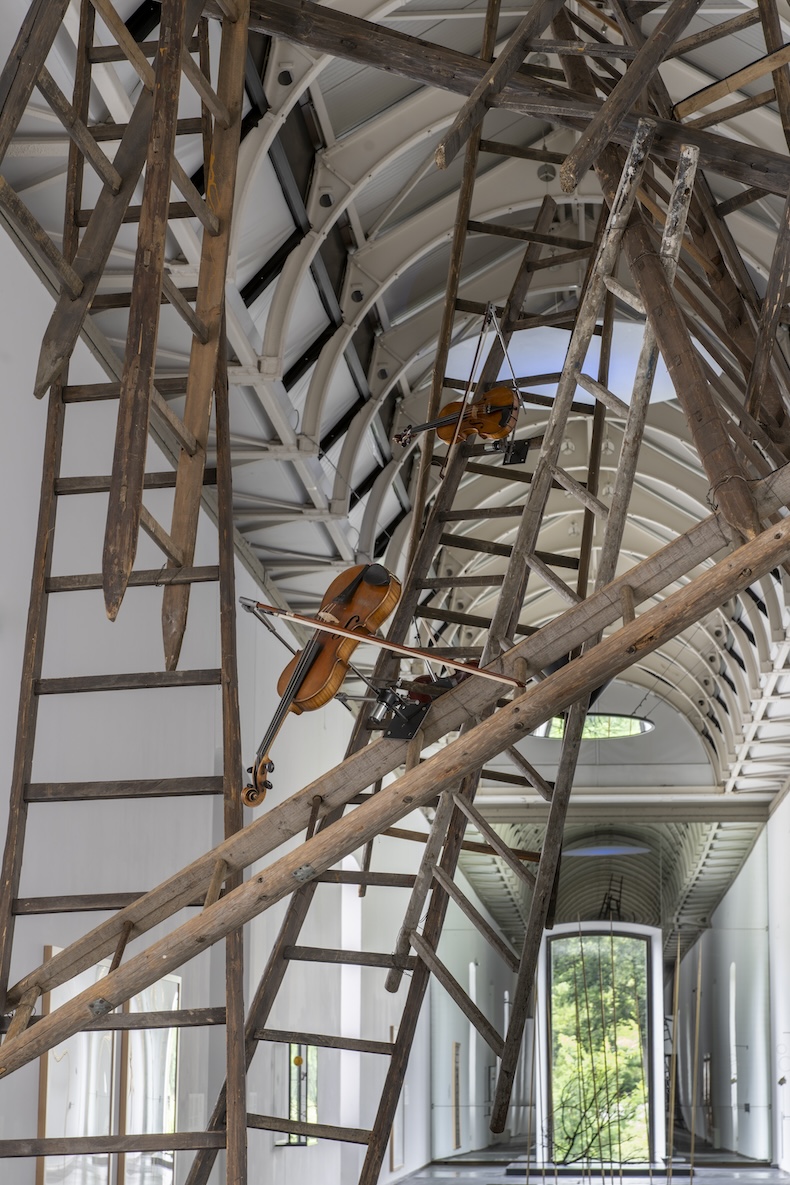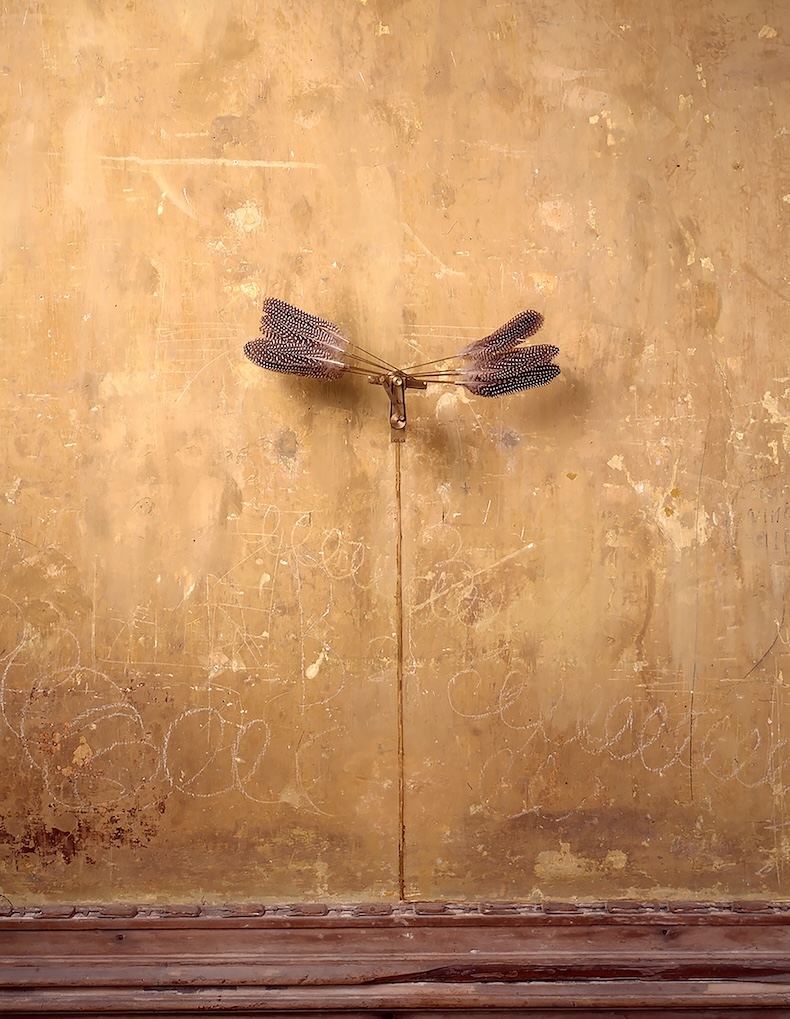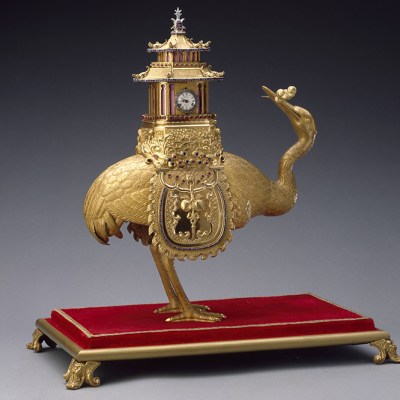From the July/August 2025 issue of Apollo. Preview and subscribe here.
In ‘Cutting Through the Past’, a retrospective of Rebecca Horn (1944–2024) at Castello di Rivoli, near Turin, things are constantly being spiked and sliced and snipped and ripped open. The title of the exhibition is taken from a work from 1992–93 in the Castello’s permanent collection. Five wooden doors stand in a circle like stones. Some of them have peeling paint, others are missing panes of glass. In the middle, a tapered metal rod constantly revolves, digging its way through a series of pre-made grooves in the edge of each door, as though worrying at the same, small wound.
Spikes are a constant feature of Horn’s work. We could regard this as a flourish of nominative determinism, or a necessary part of her wider symbolic and textural language in which sharp points are always meeting softer, equally erotically laden materials (feathers, flesh, butterflies, hair, strips of fabric). The exhibition, curated by Marcella Beccaria in coordination with the Haus der Kunst in Munich, which hosted an earlier version last year, offers a thorough but not overwhelming insight into the late German artist’s world of machines, videos and installations. With its mix of baroque architecture and modern Corten steel, the Castello is an apt setting for Horn’s work – meeting her tensions and contradictions with its own.

Horn, born in Germany in 1944, was taught to draw by a Romanian governess, and moved frequently. Her first artistic reckoning came when she was an art student in Barcelona and forced to enter a sanatorium after inhaling fibreglass particles. Both her parents died during her year of rehabilitation. It was a strange, sequestered time in which physical imprisonment was compensated by an imaginative longing she’d later describe as a ‘burning inside.’ In the aftermath, she created a series of prostheses and costumes that both extended the reach of the body and also weighed it down, Horn dressing both herself and other willing (or, at least, begrudging) participants in unicorn horns, peekaboo feathered contraptions, hedgehog-like pencil masks, and long, spindly finger extensions. Later, as the scale of her ambition and her works increased, she made a series of kinetic machines which, in their movements and awkward pauses, precise repetitions and clumsy failures, alluded to a complex inner life – a ‘soul’ of their own.
One of these inventions greets visitors at the entrance. Peacock Machine was originally created by Horn for documenta in 1982. It, too, is composed of a series of steel spikes. Fanned, they resemble a peacock’s tail puffed out in full, ready for the mating season. Folded, it is as if the bird is bowing to the room. Forever going through its courtly ritual, its motions are palpable as one moves through the long, vaulted wing of the gallery. Other machines have less certain rhythms. Feathered pieces jerk and spin at random intervals, often waiting, it seems, until one’s back is turned to burst into action. Concert for Anarchy (2006) consists of a piano, suspended from the ceiling, that periodically releases its keys in a giant, atonal clang, letting them hang out like spilled guts. Tower of the Nameless (1994), dedicated to the victims and refugees of war in former Yugoslavia, is constructed from a set of vast, interlocking ladders that climb towards the ceiling, their rungs studded with violins whose mechanical bows saw away sometimes solo, sometimes in eerie concert.

Horn was adamant that her machines should be understood as human: flawed, complex, changeable. ‘If a machine stops, it doesn’t mean it’s broken. It’s just tired,’ she explained to the writer Stuart Morgan. ‘I don’t want them to run forever. It’s part of their life that they stop and faint.’ In an interview with the critic and curator Germano Celant, she was pressed on their other physical states. Could these machines have orgasms? Her response was nonchalant. ‘Some of them do, sure.’
In the abstract, these ideas may seem absurd or even hysterical. How exactly might a machine pass out or come? How could it feel? But when you’re in the room with them, it all makes a kind of intuitive sense. These are not works that one looks at. Rather, we spend time in their presence. And, as with any presence, they provoke a range of possible reactions. The whirring rod in Cutting Through the Past quickly becomes unbearable, its smooth repetition suggesting a lesson never learned, a fault line appearing again and again without respite or revelation. The sheet music set aflutter in Floating Souls (1990) seems to require such exertion from the thin metal arms lifting the papers that I found myself willing them on, feeling the same empathy that comes in watching an exhausted dancer pushing themselves to the limit, hoping they make that final leap. Before an exhibition at the Tate in London in 1994, Horn described this quality of presence: ‘As the visitors come and go, the different sculptures seem to be holding a conversation among themselves. Strangers walking in are involved in this dialogue.’

Spending a couple of hours with Horn’s works is an intense experience – not least sonically, as snatches of violin and zaps of electricity mix with the noises from videos: scratching, chopping, clicking, monk-like chanting. But it is ultimately a reassuring one. Watching all this repeated effort, one begins to accept and even welcome the possibility of failure. To try is to risk getting it wrong – to face glitch, rupture, disappointment – but the trying is the point.
While I was in Turin, I also visited the Museo di Anatomia Umana Luigi Rolando, home to a 19th-century collection of wax figurines, infant skeletons, dried brains and other sundry body parts. One vitrine held a series of arms and hands preserved with their nerves and blood vessels intact: delicate networks of strings looped and laced around the bones. Horn’s machines may simulate bodies, but they also remind us that our bodies are machines. Nerves are a physical fact, a bundle of fibres that make sensation possible. In ‘Cutting Through the Past’, one appreciates not only Horn’s idiosyncratic vision but also her sensitivities as a physical and emotional anatomist with a blade in one hand and a feather in another.

‘Rebecca Horn: Cutting Through the Past’ is at the Castello di Rivoli, Turin, until 21 September.
From the July/August 2025 issue of Apollo. Preview and subscribe here.



